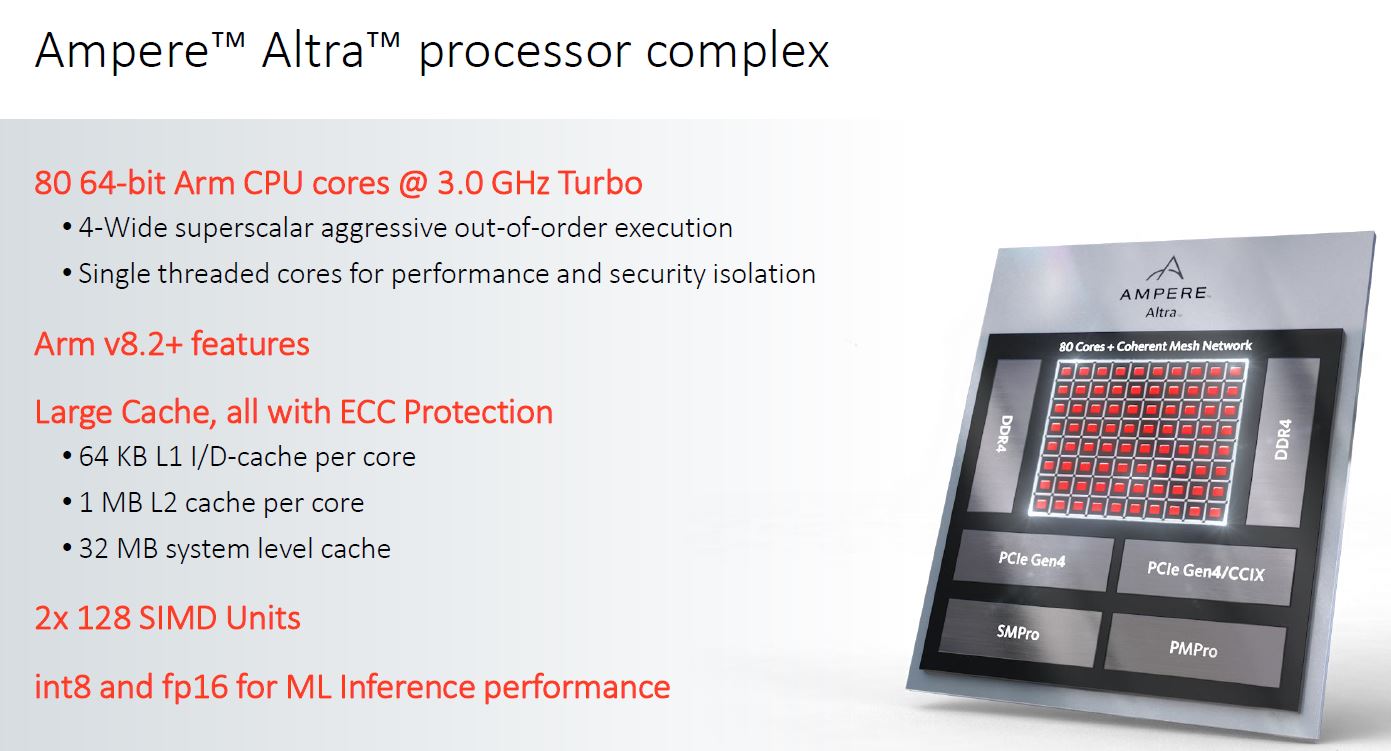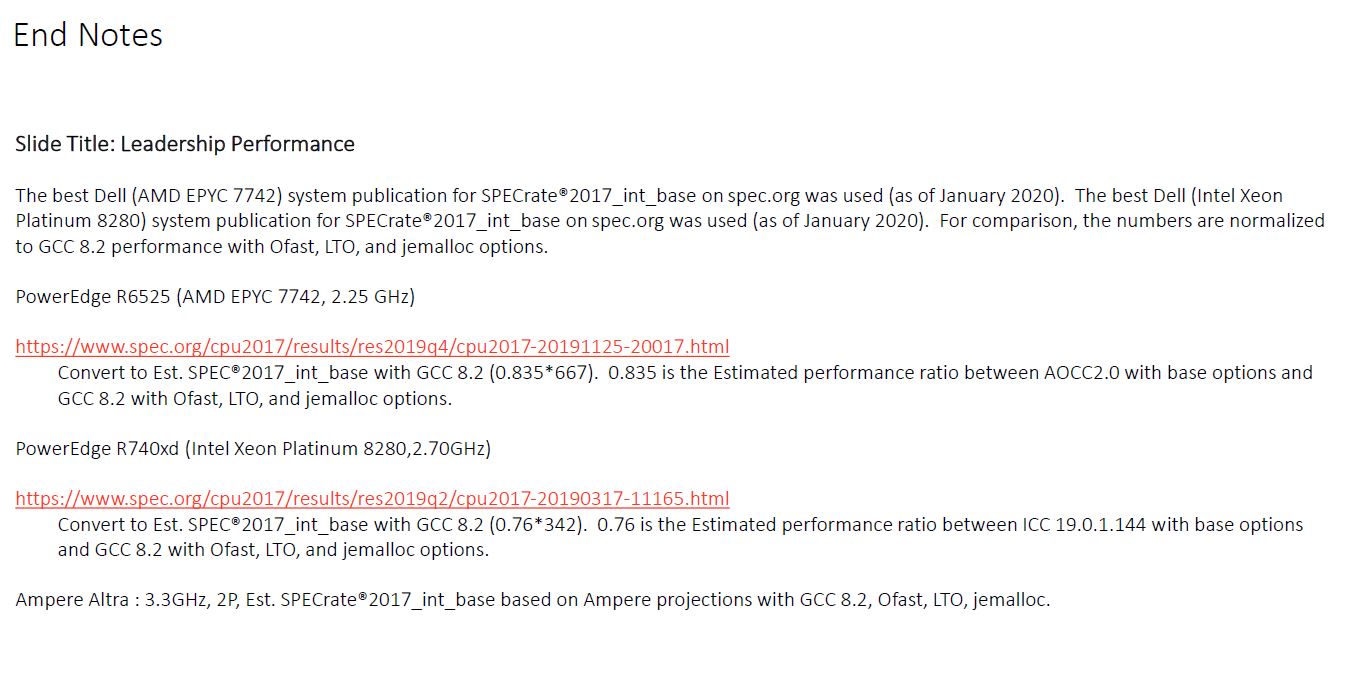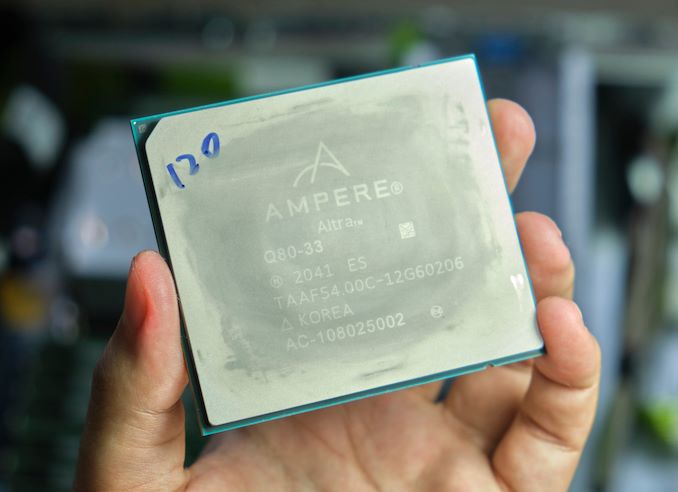
Ampere Altra Launched with 80 Arm Cores for the Cloud
The Ampere Altra 80-core Arm server CPU is upon us with 128 PCIe Gen4 lanes per CPU, CCIX, and dual-socket server capabilities. We assess the impact.







The actual EPYC CPU turned out to have eight 75mm^2 chiplets and a ~450mm^2 14nm IO die. A hypothetical monolithic die to fit those together might straight up exceed what can be fabbed on 7nm due to the size alone.
AMD did tell us at Rome and chiplet introduction that max monolithic version they could have produced was 48c version, and that would have been extremely low yielding product.

That is just silly. They didn't 'have to' do it like that. Not sure how much less profit Ampere could hope for if they offered CPUs ranging from 6 to 64 cores and had to design, tape out, validate and market a lot of different monolithic chips. Yeah everyone can say about Intel what they want, but it's obvious that their margins are shrinking. AMD made a business choice based on the markets they are present in.The more impressive thing is that Ampere can put 80 (maybe 128?) N1 cores into one single die w/ I/O. AMD on the same process had to resort to a ton of chiplets for 64 cores, and Intel's Ice Lake-SP supposedly only fits 42 cores into a single die.
If nvidia are able to purchase Arm, I can't imagine nvidia cutting off or manipulating any of the major vendors like Apple, Amazon, MS etc. - 1) because they all have (or in the case of Amazon/Annapurna, likely have) architectural licenses, and 2) because nvidia is a fleck of corn in Apple, MS, and Amazon's stool when it comes to monetary weight. If nvidia try to manipulate those licenses or create problems, it will probably only serve to have Apple, MS, and Amazon take nvidia through an extensive and expensive legal spanking.I'm a bit skeptical about what will be the future of ARM servers. If the sale goes through to nVidia, that becomes a potential threat to a lot of the in-house development efforts unless companies like Google; Microsoft; and Amazon (like Apple) snag an architecture license and stay on ARMv8.x in perpetuity. I strongly suspect that nVidia intends to hijack the entire Neoverse platform and use it to their advantage.
If nvidia are able to purchase Arm, I can't imagine nvidia cutting off or manipulating any of the major vendors like Apple, Amazon, MS etc. - 1) because they all have (or in the case of Amazon/Annapurna, likely have) architectural licenses, and 2) because nvidia is a fleck of corn in Apple, MS, and Amazon's stool when it comes to monetary weight. If nvidia try to manipulate those licenses or create problems, it will probably only serve to have Apple, MS, and Amazon take nvidia through an extensive and expensive legal spanking.
Anyway, my expectation is that the future of Arm servers might actually be more robust.
Not sure who has perpetual architectural licenses, but I would be surprised if anyone had such licenses for ARMv9. It's not that they'll try to manipulate existing licenses . . .
But boy did they try to make it hapoen painfully hard...If they try to play that game, I would not be surprised if the ecosystem stayed with ARMv8. Remember when Intel tried to move everyone over to their locked down Itanium ISA, that only Intel could produce chips for? Just because the platform holder tries to make something happen, doesn't mean that everyone else will go along with it.
if i've learnt anything over 15 years of designing/selling Datacentre infrastructure is the market in general always cares way less then you think they do, you have to have massive undeniable advantage over multiple generations to gain inertia.

AMD EPYC 7742 2P 200.99
Intel Xeon Platinum 8280 2P 229.32
Ampere Altra Q80 - 33 2P 282.64AMD did tell us at Rome and chiplet introduction that max monolithic version they could have produced was 48c version, and that would have been extremely low yielding product.
Some people want to point to these Ampere results and say "well, ARM has caught up, and costs less, x86 is doomed". Things don't happen that quickly, the people making the multi million dollar purchase decisions are cautious by nature, and aren't going to make such a choice without a lot of study and preparation and seeing others with a higher risk tolerance take the plunge first.
Even when looking at nearest future in the context of this thread - next year Altra will throw 128C 3Ghz chip. When this thread was posted, i was not taking it seriuos cause it was projections, but they have delivered and despite doom and gloom about 32MB of L3 it performs rather well as 1S machine.
In 2021 we will see AMD ZEN3 server chip with probably same 64C ~same clocks. Tough place to compete with 128C ARM chip that is no longer retarded in single threaded perf. And AMD is not exactly mindshare/ecosystems champion either.
But in ARMs case -> the custom cloud, Apple ecosystem, every damn Android phone, Fugaku all point tentacles at the writing on the wall that the end of x86 having technological ( read perf, mindshare) superiority is upon us.
Even when looking at nearest future in the context of this thread - next year Altra will throw 128C 3Ghz chip. When this thread was posted, i was not taking it seriuos cause it was projections, but they have delivered and despite doom and gloom about 32MB of L3 it performs rather well as 1S machine.
In 2021 we will see AMD ZEN3 server chip with probably same 64C ~same clocks. Tough place to compete with 128C ARM chip that is no longer retarded in single threaded perf. And AMD is not exactly mindshare/ecosystems champion either.
If they try to play that game, I would not be surprised if the ecosystem stayed with ARMv8.
I honestly cannot see any of the existing and potential ARM chip manufacturers be willing to argue for Nvidia's takeover of ARM.
So, maybe 128C Altra can beat Milan. More likely it will be really close, winning some and losing others. Can it beat server Zen 4? Almost certainly not.
If SVE2 is effectively locked-up behind ARMv9 and its successors, then ARMv8 license holders will be stuck on NEON forever. Unless they can somehow incorporate a different SIMD ISA extension without violating their license. Which Apple sort-of did with AMX.
SVE2 is already an optional extension for AArch64, it is too late to "lock it up"
We still don't know what AMX is, and whether it is an ISA extension running on Apple's ARM CPU cores.
I'm a bit skeptical about what will be the future of ARM servers. If the sale goes through to nVidia, that becomes a potential threat to a lot of the in-house development efforts unless companies like Google; Microsoft; and Amazon (like Apple) snag an architecture license and stay on ARMv8.x in perpetuity. I strongly suspect that nVidia intends to hijack the entire Neoverse platform and use it to their advantage.
new M1 mac?edit: and now that I think about it, I would really like to be able to buy a Q32-17 machine. I'm sick of waiting for Rockchip to release the RK3588. Not anywhere near in the same ballpark, but hey if you want something you can actually buy and own at home that isn't an A72 or similar . . . what else are you going to do? I mean, besides use a phone?
The truth is, every company strives for proprietary tech since open tech gives you no business moat. You don't see Windows OS, Microsoft Word, Apple SoCs, Adobe Photoshop, etc. being open-sourced. Heck, AMD doesn't open source most of their own inventions. The only things that AMD makes open are things that it knows Nvidia is way better at so making them open is just a way to gain more adoption.But that will only go so far. Delayed or no licensing of ARMv9 will simply just kill the ARM server ecosystem. Any trust in a fair treatment and fair chance to compete will be gone. And with NV being then the only vendor of ARMv9 who will invest in software in it? Let's be honest. That's the biggest problem. Yes it wouldn't surprise me if NV is this short-sighted but it will fail. Even more so the fully closed server approach. That would be a big win for AMD as essential big corps will probably then help AMD with their rocm with developer time.
Customers who bought Turing cards under the false hope they could game with RT on in less than 2 years and more than 5 worthwile games did the heavy lifting regarding real-time RT thus far.The truth is, every company strives for proprietary tech since open tech gives you no business moat. You don't see Windows OS, Microsoft Word, Apple SoCs, Adobe Photoshop, etc. being open-sourced. Heck, AMD doesn't open source most of their own inventions.
One exception I can think of is Android and Chrome being open-source. But Google makes money through the Android App Store, emphasizes its own services on Android, and makes Google the default search engine on Chrome.
Nvidia has been hugely innovative with things such as CUDA, RTX, DLSS, Tensor Cores, etc. There's no reason to expect Nvidia to open-source their inventions so that other companies can copy them. Nvidia also did the heavy lifting in getting Ray Tracing software support onto DirectX and Vulkan, which AMD can now benefit from.
This "closed ecosystem" label thing for Nvidia only exists in the DIY PC Master race or elite gamer community. These communities want inventions to be made standard so that many companies can produce parts and compete on price. In B2B, most businesses don't care. If closed, proprietory Nvidia tech can solve their business problems, then they will buy Nvidia regardless.
Lastly, Nvidia is now the biggest semiconductor company in the world by marketcap if you don't count TSMC. They didn't get to this size by being stupid. They got here because they provided a lot of value to their customers.
new M1 mac?


